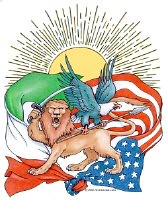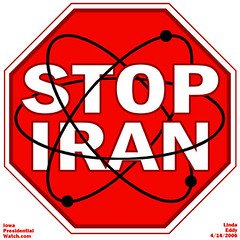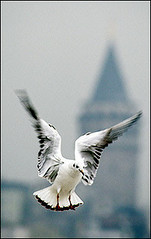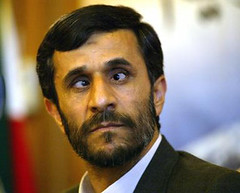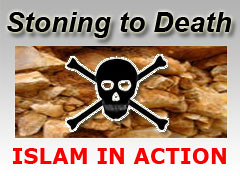Wednesday, January 31, 2007
USA Gangs Potentially Linking to Islamic Terrorism
Monday, January 29, 2007
MUST READ - James Baker Works to Establish Direct Diplomatic USA - Iran Ties
Defense & Foreign Affairs Analysis. By Gregory R. Copley, Editor, GIS. Former US Secretary of State James Baker, who co-chaired the recent US Iraq Study Group — the main recommendations of which were rejected by the George W. Bush Administration — is working indirectly and behind the scenes to bring about direct diplomatic ties between the US and Iran. This is in defiance of Bush White House policy which essentially has said that encouraging direct negotiations with the Iranian clerical leaders would legitimize and strengthen the power of the Iranian mullahs, making it more difficult for Iran’s secular opposition to bring about democratic change in the country. The visit on January 25-26, 2007, to Tehran by the Secretary-General of the Saudi National Security Council, Prince Bandar bin Sultan, for talks with his Iranian counterpart Ali Larijani on “the critical situation in Lebanon” was, in fact, to scope out a more broadly-based resolution to the Iran-US impasse along the lines of the so-called “Baker Plan” devised by the Iraq Study Group. The Iraq Study Group recommendations had already been discounted and discarded by the George W. Bush White House, but the Bandar maneuver with Ali Larijani is an attempt to sidestep that in order to resume the process of US recognition of the clerical leadership in Iran. The move highlights not only the ongoing Baker-Bandar link — which has been close on a financial and personal basis for decades — but also the growing power of Prince Bandar, the former Saudi Ambassador to the US and son of the Saudi Crown Prince and Deputy Prime Minister, Sultan bin ‘Abd al-’Aziz al Sa’ud. Prince Bandar in December 2006 caused to have removed his successor as Saudi Ambassador to the United States, former Director General of the General Intelligence Directorate (GID) Prince Turki al-Faisal, who he apparently saw as a rival. Although Prince Bandar’s father is in line to succeed to the Throne, there have been recent suggestions that his father could — with the passing of King ‘Abdallah bin ‘Abd al-’Aziz al Sa’ud (should Sultan outlive him; they are both of similar ages) — step aside and push Bandar as the candidate to be the next King. Moreover, Prince Bandar’s power in the Saudi structure is now such that suggestions that he replace Prince Sa’ud al-Faisal bin ‘Abd al-’Aziz Al Sa’ud as Foreign Minister are privately being sneered at as being beneath Prince Bandar’s power level. The Bandar-Larijani talks, then, should be seen in the light of Bandar’s power and ambition, and in light of Bandar’s close personal connection with James Baker. The talks between Bandar and Larijani, thus, gave Larijani, Secretary of Supreme National Security Council (SNSC), and the Iranian clerical leadership considerable optimism that they could circumvent the public position of US Pres. George W. Bush by working with Baker — through Bandar — and with the Democratic Party leadership in the US Congress. It seemed equally clear following initial talks between Bandar and Larijani that the Iranian official felt himself to be confident of his knowledge as to strategic approaches by the Bush White House with regard to Iran. Although the January 26, 2007, talks in Tehran were ostensibly primarily related to the developing crisis in Lebanon, it was apparent that talks on the US-Iranian framework both incorporated and transcended the Lebanon issue. But it was the crisis in Beirut which provided the ostensible cause for the developing round of talks between Bandar and Larijani. Larinjani had delivered a message to Saudi King ‘Abdallah on January 14, 2007, precipitating the visit by Bandar to Tehran where he met with “Supreme Leader” “Ayatollah” Ali Hoseini-Khamene‘i on January 25, 2007, before meeting at length next day with Larijani. It was clear that Bandar’s contacts in Tehran excluded Pres. Mahmud Ahmadi-Nejad, who is now in open dispute with the “Supreme Leader”. [Saudi-Iranian links also took place in late January 2007 at the level of foreign ministers, between Saudi Foreign Minister Prince Sa’ud al-Faisal and Iranian Foreign Minister Manouchehr Mottaki.] Indeed, as an aside, the growing Baker/Bandar/Sultan links with the Khamene’i/Larijani links gives an implied boost to the position — currently informal — of former Iranian Pres. Ali Hashemi-Rafsanjani, now being projected as a “moderate” cleric, as opposed to the radical position of Ahmadi-Nejad. Iranian secular opposition and military figures believe that this characterization suits the Baker approach in the US, but disguises the fact that Rafsanjani is, in reality, no moderate, but is being portrayed in that light in comparison with the current President. Iranian sources said that offering up Rafsanjani as a leadership alternative to Ahmadi-Nejad could be portrayed in the West as a dampening down of Iranian anti-US strategic ambitions, although this was not the case: Rafsanjani has traditionally been one of the principal supporters of the use of terrorists as a proxy weapon against the West, and of the Iranian nuclear weapons program, much of which he pioneered. The Iranians, for their part, made little or no pretence on January 26, 2007, that the Tehran talks were about Lebanon, citing almost exclusively the common areas of agreement on regional security with Saudi Arabia. Not that Lebanon was excluded from the agenda. On the contrary, Iran used the consensus that the Bush Administration was incapable of stopping Tehran’s strategic momentum in order to bring Saudi Arabia — at least the Sultan-Bandar camp — into Iran’s fold by offering it more access, for example, to the Syrian leadership. Moreover, Larijani’s visit to Beirut in late January 2006 gave evidence that he felt that Iran had absolutely succeeded in its strategies to dominate Lebanese politics and to assure the veto capability of its surrogate, HezbAllah, in Lebanese affairs. Subsequently, Larijani also made it clear that he felt that the US could not — through the United Nations — stop Iranian plans for nuclear enrichment as part of Iran’s indigenous nuclear weapons program. But it was Larijani’s belief that he had insight into US strategies toward Iran which highlighted the strong probability that Bandar reflected conversations which he had earlier had with James Baker, in which Baker clearly alluded to White House positions. Larijani denigrated the US position against Iran as being merely “psychological warfare”, and dismissed the likelihood of a military threat from the two US Navy carrier battle groups in the region. Larijani’s comments made it clear that he was aware that the White House favored a campaign of psychological operations against the Iranian clerics over the use of actual military force, the threat of which was ideally intended to be more symbolic. Tehran was certainly proceeding with its power projection into Iraq and Lebanon based on this assumption, and was disregarding both the US and the United Nations accordingly. However, although former Secretary of State Baker may have conveyed what he felt was the position of the Bush White House — based on his privileged position as a close friend of the current President’s father (former Pres. George H. W. Bush) and a colleague of the new US Secretary of Defense, Robert Gates, quite apart from his ongoing contacts in the State Dept. — it is clear that both Pres. Bush and Vice-Pres. Richard Cheney are, in fact, losing patience with Baker for advocating Iraq and Iran policies so at odds with those of the White House. Moreover, the moves by Pres. Bush to authorize attacks in Iraq on Iranian personnel — essentially reversing a policy in place until a week or so earlier — showed that the US Executive Branch could still maneuver in ways to surprise Baker, Bandar, and the Iranian clerics.
Sunday, January 28, 2007
ISLAMIC POLITICAL PRISONERS SOCIETY
How Democrats Lost Iran and Now Could Lose Iraq
Saturday, January 27, 2007
Run for Your Lives!
DEFENSE & FOREIGN AFFAIRS - Special Analysis
Thursday, January 25, 2007
RCI NEWS BRIEFS
HEADS UP - SERIOUS ACTIVITY
Monday, January 22, 2007
Saturday, January 20, 2007
NEW CLOCK
BEHIND THE IRAQ / IRAN CAPTURE NEWS
FOR THOSE FEELING SORRY FOR SADDAM HUSSEIN


